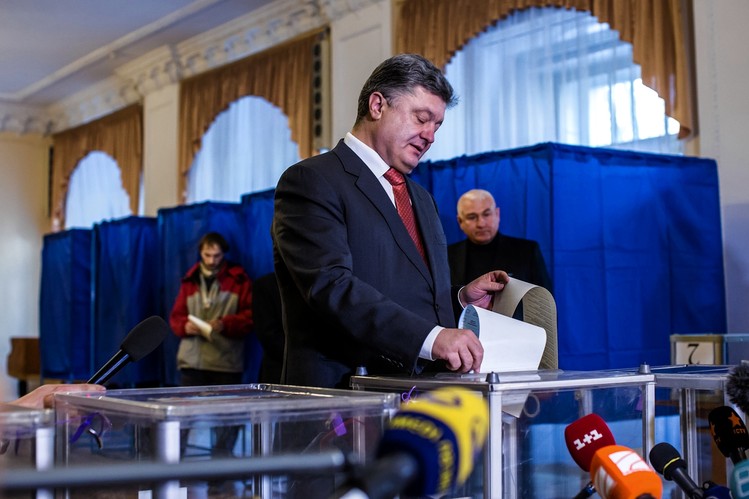
Kremlin’s Policy Boomerangs With Ukraine’s Parliamentary Election Results
Publication: Eurasia Daily Monitor Volume: 11 Issue: 195
By:

Russian President Vladimir Putin exuded confidence about his Ukraine policy during the Valdai Club discussion in Sochi on October 24. Conceding that Ukraine is a European country, Putin repeated his line that “Ukraine was pieced together as a state, and it is a composite state, and we proceed from this historical given.” Moreover, Putin openly staked a sphere-of-influence claim on Ukraine, in words he must have deemed humorous: “The Bear is the master on his turf” (Interfax, gazeta.ru, October 24),
Two days later, on October 26, Ukraine elected a new Verkhovna Rada (parliament) with a solidly pro-Europe majority for the first time since the country’s independence. By the same token, the vote reaffirmed confidence in President Petro Poroshenko and the team of Prime Minister Arseniy Yatsenyuk (in office since June and since February, respectively) on the basis of their pro-Europe agendas. This political watershed, as viewed from outside Ukraine, tends to obscure an even deeper change ongoing in many parts of the country.
That deeper change can be seen in the rejection of subordinate status vis-à-vis Russia by a critical mass of Ukrainians, the surge of civic nationalism, public initiatives and the volunteer movement. Those processes helped shape the outcome of the parliamentary elections just held. Results of subsequent elections will fluctuate, but the transformation of consciousness now underway has made new substantial inroads with enduring effects. Above and beyond electing this parliament, Ukraine has distanced itself conclusively from Putin’s grand design of a “Russian World” (“Russkiy Mir”).
Putin’s policies toward Ukraine boomeranged against the Kremlin, as seen in the parliamentary election results. Russia’s multidimensional aggression accelerated these political changes in Ukraine.
In February of this year, Moscow had openly embarked on a policy of breaking up the Ukrainian state. Apparently, the Kremlin no longer saw any point to relying on the central government in Kyiv, irrespective of political color. Then-president Viktor Yanukovych’s government, presumed to be Russia-friendly, had brought Ukraine to the threshold of signing an association agreement with the European Union. This forced Russia to buy back that government’s dubious loyalty with multi-billion-dollar credits and natural gas price discounts. The same government of the Party of Regions then failed ignominiously to handle the Maidan protest movement, ultimately making room for a pro-Western government in Kyiv.
Watching Ukraine slip out of Russia’s orbit irreversibly, Moscow activated a strategy to carve out “Russian-speaking” territories from Ukraine and bring them under Russia’s direct control. This strategy—to the extent to which it worked out—meant removing large numbers of Russia-oriented voters from Ukraine’s presidential and parliamentary elections in Ukraine’s jurisdiction.
Russia’s annexation of Crimea subtracted 1.5 million reliably pro-Russia voters from Ukraine’s elections. Those elections had been, as a rule, closely fought along east-west lines, and Russia was heavily vested in the outcomes. By annexing Crimea, however, Putin tipped mainland Ukraine’s electoral balance against pro-Russia forces—and not only through the arithmetical effect, but also through the political backlash that was bound to result in most of Ukraine.
This process advanced further with the declared secession of the Donetsk-Luhansk “people’s republics” from Ukraine. At present, an estimated four million voters reside in the Russian-controlled parts of the Donetsk and Luhansk provinces (a region collectively known as Donbas), and were prevented from voting in Ukraine’s parliamentary elections on October 26. The final returns confirm a pro-Europe and nationally-minded majority of approximately two thirds in the new parliament (Ukrinform, October 30).
Undoubtedly, Moscow did expect that its Crimea and Donbas land-grabs would shift the political balance in the rest of Ukraine dramatically, all but guaranteeing a pro-Europe parliamentary majority and government in Kyiv. To counter such a process, the Kremlin called for Ukraine’s “federalization” into semi-independent units. And it launched the Novorossiya project, targeting six more provinces in Ukraine’s east and south, at the moment of Ukraine’s maximum vulnerability.
These Russian plans are now defeated or on hold. Except for parts of the Donbas (see above), Ukraine has retained control of the country’s east and south through local coalitions of forces loyal to the Ukrainian state. Their array comprises parts of the local administrative-economic nomenklatura formerly associated with the Party of Regions, local business interests, high-profile “oligarchs” in several cases, non-compromised elements of the state security services, and volunteer battalions of various political tendencies, including the radical right. Traditional nationalists from Ukraine’s west and Russophones from Ukraine’s east have joined forces in local coalitions, stabilizing vulnerable parts of the country. Such local, ad hoc coalitions have proven indispensable to sustaining the broader political consensus as reflected in the October 26 parliamentary elections. Social hardships during the upcoming winter will put this consensus to a hard test.




